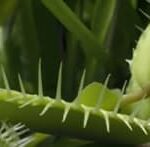As an Amazon Associate, this site earns commissions from qualifying purchases. For more details, click here.
There is a lot of confusion about dormancy in Mexican butterworts (pinguicula or ping to growers). These are tropical plants so they do not go dormant right? Mexican pinguicula is indeed a tropical plant, but they do go through dormancy, albeit in a different way.
During dormancy, the leaves of Mexican butterworts turn succulent, stop eating and need little to no water. Growth slows down, but the plant will start producing carnivorous leaves again at the onset of spring.
How Mexican Butterworts Go Through Dormancy
Tropical plants thrive in warm, humid conditions and do not enter dormancy. Mexican butterworts or tropical butterworts are somewhat of an exception. We say somewhat because their dormancy differs from other perennials.
To be clear: Mexican butterworts are tropical plants, but they go through dry dormancy or a succulent phase in winter. These plants do not die during the cold season, but shed their carnivorous leaves in favor of succulents. As winter draws to a close, carnivorous leaves start growing again.
The dormancy timeline varies slightly depending on the species, but usually it is similar to Venus flytraps. The growth period is from spring to summer, and during fall you will see signs of dormancy.
Whereas plants shed leaves and shrivel during dormancy, tropical butterworts like p. weser are different. They stop making carnivorous leaves and produce non-carnivorous ones. These are typically thin leaves stacked over each other, the colors depending on the pinguicula variant. These leaves do not digest insects, which makes sense as prey is scarce during winter.
How to Induce Dormancy
Mexican butterworts need to go through this dry dormancy,. If they do not it will affect their growth and development in the future. If your location cannot provide the conditions necessary for natural dormancy, you can induce it.
You can force a pinguicula to go dormant through reduced watering, shorter photoperiod and less frequent feeding during the fall season. Lowering the temperature can help though not as much as reducing photoperiod, feeding and water.
Do not expose Mexican butterworts to freezing temperatures. These are still tropical plants and they will not survive a winter freeze.
You have to do this slowly so as not to weaken your pinguicula. This should also be done during mid to late fall when the plant starts making succulent leaves. Do not force dormancy during its growth period in spring and summer.
These are only applicable to many but not all Mexican butterworts and other tropical pinguicula. Some butterworts do not go through any sort of dormancy at all. This is one of the reasons why it is very important that you know what type of pinguicula you own, as cultivation can and often varies.
When dormancy ends, water the plant until the soil is moist. If you are using the tray method, wait until the water has evaporated from the tray before adding more. Use only purified water like Smartwater because tap water contains potentially harmful chemicals.
How to Take Care of Dormant Mexican Butterworts
Before winter approaches, you should recognize the signs of dry dormancy. With Mexican butterworts the most obvious is the changing leaves, from carnivorous to succulent. Other signs include loss of appetite and carnivorous leaves being discarded.
When these signs emerge, it means the plant is ready to go dormant. Here are some tips on how to care for pinguicula during this period.
Due to the many variants, it is possible that your Mexican butterworts may have a slightly different timetable. Yours might take a bit longer to go dormant, and it might take longer to emerge from it as well. This is nothing to be concerned about as the species behave differently.
Water
When Mexican butterworts have grown succulent leaves, you can stop watering it. Fully formed succulent leaves are a sign the plant is now dormant. You can stop watering or reduce to a very low volume. You can resume after the pinguicula has emerged from dormancy.
Once tropical butterworts are done with dormancy, you should water to keep the soil moist. You may use the tray method but do not use too much water as that can precipitate root rot.
Note that some winter Mexican butterworts will benefit from a little water. Small, succulent leaves should not be watered. Large succulent leaves will thrive with a lightly damp soil.
Soil and Container
Do not change the soul during dormancy. You can repot the plant when it has grown carnivorous leaves again and move it to another container. This is the best time to change the soil.
The best options are perlite, peat moss, sand and vermiculite. You can also grow Mexican butterworts in 1:1 peat moss and perlite, the typical mix for pitcher plants.
Glazed or plastic containers are fine for tropical butterworts. Some have been able to nurture pinguicula in containers without drainage holes, but most prefer pots with holes as it is easier to manage.
During the growth period, keep the soil moist. As its carnivorous leaves get smaller, it is a sign that dormancy is coming. Slowly reduce watering and leave the soil dry during winter. You need to cut back on watering of the soil slowly. If you do suddenly it will damage the plant.
Lighting, Humidity and Temperature
Temperature. Mexican butterworts thrive in 41-50 F (5-10 C) temperature during dormancy. As long as it does not drop below freezing the plant will be fine. During their growth period, these plants prefer 67-77 F (2–25 C).
Humidity. Mexican pinguicula will do fine at 50% humidity. Some species prefer lower humidity levels during dormancy, but this can vary among species.
Keep the humidity low during dormancy to prevent mold buildup. This is another reason why you should not water these plants during winter. The last thing you need is for mold to appear.
Lighting. The ideal lighting for Mexican butterworts is direct sunlight in the morning and partial lighting during the hottest part of the day. But it is possible to acclimatize a pinguicula to several hours of direct sunlight, but you have to do it slowly.
Dormant plants will be fine under reduced sunlight. You can use artificial lighting like GooingTop LED Grow Lights if necessary. Do not expose the plant to full sunlight or it might suddenly snap out of dormancy.
Tropical plants are usually grown indoors to protect them from winter freezing. Mexican pinguicula can grow outdoors provided it is not freezing temperature. Also keep in mind that these plants can suffer from too much sunlight. Provide shade for the plant if the light intensity becomes too harsh.
As winter comes to a close, you can slowly increase its exposure to sunlight. When you see carnivorous leaves appearing, the plant is ready to feed again. You can keep the plant indoors or take it outside to get light. If you grow pinguicula indoors under intense artificial lighting, the plant will turn red or pink. This is normal for these plants.
You can grow Mexican butterworts in a greenhouse or terrarium, assuming the conditions are favorable. Another option is to grow the plant in a south facing window.
Feeding and Nutrition
Butterworts do not eat during dormancy. The reason they discard those bug eating leaves is to conserve energy. Since there are no bugs to eat, the plant saves its resources until spring.
During dormancy you do not have to worry about feeding your plant. Once its carnivorous leaves start growing again, the plant will resume eating.
Pinguicula are harmless to humans and pets so you can feed them without worry. If your pinguicula is outdoors, you will probably see quite a few gnats, ants, flies or other bugs stuck on its leaves. Butterworts also eat bloodworms and mealworms, live or dead. Just drop the worm onto the leaf and the plant will eat it.
Conclusion
Dormancy is usually the most difficult part of plant care, including Mexican butterworts. Knowing the signs of dormancy makes this easier, so take the time to learn as much about Mexican pinguicula as possible.

My fascination with carnivorous plants began many, many years ago with Venus Fly Traps. Now I am more than happy to impart what I know with other enthusiasts and those who are curious about meat eating plants.



